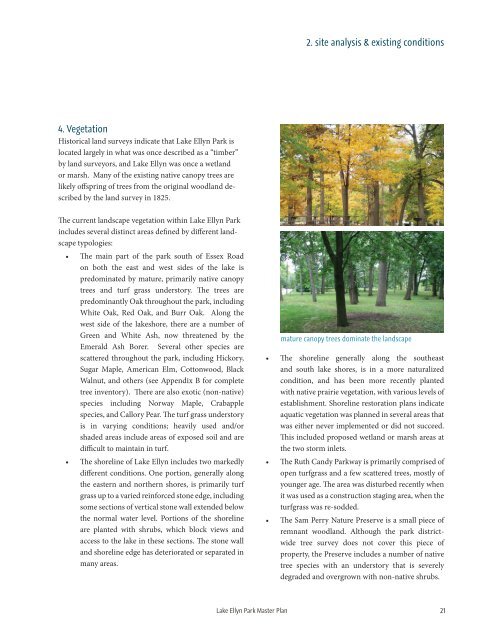Lake Ellyn Park 2013 Master Plan
Lake Ellyn Master Plan Final - Glen Ellyn Park District
Lake Ellyn Master Plan Final - Glen Ellyn Park District
- No tags were found...
Create successful ePaper yourself
Turn your PDF publications into a flip-book with our unique Google optimized e-Paper software.
2. site analysis & existing conditions<br />
4. Vegetation<br />
Historical land surveys indicate that <strong>Lake</strong> <strong>Ellyn</strong> <strong>Park</strong> is<br />
located largely in what was once described as a “timber”<br />
by land surveyors, and <strong>Lake</strong> <strong>Ellyn</strong> was once a wetland<br />
or marsh. Many of the existing native canopy trees are<br />
likely offspring of trees from the original woodland described<br />
by the land survey in 1825.<br />
The current landscape vegetation within <strong>Lake</strong> <strong>Ellyn</strong> <strong>Park</strong><br />
includes several distinct areas defined by different landscape<br />
typologies:<br />
• The main part of the park south of Essex Road<br />
on both the east and west sides of the lake is<br />
predominated by mature, primarily native canopy<br />
trees and turf grass understory. The trees are<br />
predominantly Oak throughout the park, including<br />
White Oak, Red Oak, and Burr Oak. Along the<br />
west side of the lakeshore, there are a number of<br />
Green and White Ash, now threatened by the<br />
Emerald Ash Borer. Several other species are<br />
scattered throughout the park, including Hickory,<br />
Sugar Maple, American Elm, Cottonwood, Black<br />
Walnut, and others (see Appendix B for complete<br />
tree inventory). There are also exotic (non-native)<br />
species including Norway Maple, Crabapple<br />
species, and Callory Pear. The turf grass understory<br />
is in varying conditions; heavily used and/or<br />
shaded areas include areas of exposed soil and are<br />
difficult to maintain in turf.<br />
• The shoreline of <strong>Lake</strong> <strong>Ellyn</strong> includes two markedly<br />
different conditions. One portion, generally along<br />
the eastern and northern shores, is primarily turf<br />
grass up to a varied reinforced stone edge, including<br />
some sections of vertical stone wall extended below<br />
the normal water level. Portions of the shoreline<br />
are planted with shrubs, which block views and<br />
access to the lake in these sections. The stone wall<br />
and shoreline edge has deteriorated or separated in<br />
many areas.<br />
mature canopy trees dominate the landscape<br />
• The shoreline generally along the southeast<br />
and south lake shores, is in a more naturalized<br />
condition, and has been more recently planted<br />
with native prairie vegetation, with various levels of<br />
establishment. Shoreline restoration plans indicate<br />
aquatic vegetation was planned in several areas that<br />
was either never implemented or did not succeed.<br />
This included proposed wetland or marsh areas at<br />
the two storm inlets.<br />
• The Ruth Candy <strong>Park</strong>way is primarily comprised of<br />
open turfgrass and a few scattered trees, mostly of<br />
younger age. The area was disturbed recently when<br />
it was used as a construction staging area, when the<br />
turfgrass was re-sodded.<br />
• The Sam Perry Nature Preserve is a small piece of<br />
remnant woodland. Although the park districtwide<br />
tree survey does not cover this piece of<br />
property, the Preserve includes a number of native<br />
tree species with an understory that is severely<br />
degraded and overgrown with non-native shrubs.<br />
<strong>Lake</strong> <strong>Ellyn</strong> <strong>Park</strong> <strong>Master</strong> <strong>Plan</strong><br />
21




